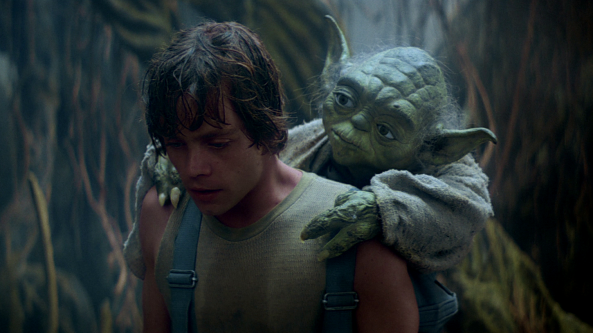The promissory elements of the sacramental prayers, especially the prayer on the bread, can be seen as an enactment of a typical heroic arc.
I’ll illustrate here with images from that typical hero’s journey, the Star Wars saga. It’s not perfect or in order, and I hope you don’t find this irreverent, as this analogy makes Darth Vader into Jesus (though there really are clearly some aspects of the Savior used in the character of Anakin Skywalker). In these pictures, Luke Skywalker is each of us as we take the sacrament.
The first thing we as individual participants do is to eat “in remembrance of the body of thy Son.”

“in remembrance of the body of thy Son”
A great hero has fallen, his life given for the good of others, and the young disciple (or in our case, disciples) who must now carry forward the legacy of his work must, first of all, mourn and find strength from the sacrifice of the elder master.

“they are willing to take upon them the name of thy Son”
The fallen master’s legacy is now conferred on the next generation, who “take upon them” (physically, spiritually, or both) some talismanic aspect of the master (be it a lightsaber or a holy name).

“and always remember him”
Here’s another example of becoming literally more like a great heroic mentor through continual remembrance–Luke’s bionic hand. In our case, eating the sacramental bread itself could fill this role. (The work and clothing of the temple fit here as well.)
Armed with committed resolve and the basic emblems of the way, the young disciple(s) now must live the way with increasing fullness, through a life of practice, tests and trials, and general faithfulness as they embark on their own version of the master’s journey. This training is ongoing and episodic, like a series of scenes in a movie franchise, or over the course of our daily lives. Either way, growing in strength through regular obedience to the laws of the way is expected.

“that they may always have his Spirit to be with them”
The reward for demonstrated faithfulness to practicing the way of this order is to have the eternal, spiritual presence of its holy divinities with the young disciple along the path of the dangerous journeys ahead. These spiritual guides offer blessings and gifts that aid the hero on his ever-maturing way (“Use the Force, Luke” or “Choose the right,” perhaps).
This pattern could also be illustrated with scenes featuring Obi Wan more, or figures like Gandalf or Dumbledore. The point here is to invest the great words of our compact little sacrament prayer with the majesty they deserve. It’s a simple routine for us, but one that can and should have profound meaning.
Keeping in mind this pattern of a heroic journey as each of us takes the sacrament each Sunday might help us realize its importance and power. It may only last a few minutes, but this ordinance has the ability to orient and refresh us after a long week of heroic journeying, and prepare us to continue fighting forward.
 One of Luke Skywalker’s frustrations in The Empire Strikes Back is that he is stuck on Dagobah while a war rages around the galaxy. His friends are racing away from the Empire while he’s standing on his head and lifting rocks in a lonely swamp. Giant ships play hide and seek among asteroids and face off against weird monsters, and he has to listen to proverbs from a little green preacher.
One of Luke Skywalker’s frustrations in The Empire Strikes Back is that he is stuck on Dagobah while a war rages around the galaxy. His friends are racing away from the Empire while he’s standing on his head and lifting rocks in a lonely swamp. Giant ships play hide and seek among asteroids and face off against weird monsters, and he has to listen to proverbs from a little green preacher.
 Q: Let’s get right to it: Is this a good movie?
Q: Let’s get right to it: Is this a good movie? 







